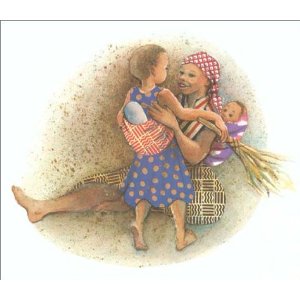 We started our February series on African folktales with an interview with a Christian from the Congo and a stack of books. We followed that up with an interview with African-raised American Girl author, Jane Kurtz. She was kind enough to share some of her memories of growing up with missionary parents in Ethiopia and how it has affected her writing. In a high point of the series for me, one of our readers, a Ugangan missionary mom, recommended the series set in Africa including Elizabeti’s Doll (Elizabeti Series)
We started our February series on African folktales with an interview with a Christian from the Congo and a stack of books. We followed that up with an interview with African-raised American Girl author, Jane Kurtz. She was kind enough to share some of her memories of growing up with missionary parents in Ethiopia and how it has affected her writing. In a high point of the series for me, one of our readers, a Ugangan missionary mom, recommended the series set in Africa including Elizabeti’s Doll (Elizabeti Series). This particular book is an Ezra Jack Keats Book Award Winner, and one I hope to find for my kids in my church or school library.
For today’s wrap-up post, I thought I’d look at one of the books my kids’ have enjoyed the most: Anansi and the Talking Melon. It’s not an award-winner. Doesn’t have art that I particularly care for, and the story is a little ho-hum in my reckoning. But both my kids have read and re-read this book more than any other Anasi story we brought home. And they’ve told it and retold it to their Daddy, when he was too busy to sit down with them and read it. It’s really become part of their imaginary life, and for that reason, I think it’s worth looking at more closely.
Plot Summary
The story begins with an elephant working in his melon garden. Anansi the trickster sits watching, waiting for the elephant to leave for a bit so that Anansi can crack into one of the melons and have a feast. Sure enough, the elephant does leave, Anansi takes a thorn, digs a small opening in the melon’s rind, and climbs inside. Very much like Pooh bear when he invites himself to Rabbit’s house for honey, Anansi eats so much that when he tries to climb back out, he is too big. But unlike Winnie the Pooh, Anansi decides to play a trick on the elephant. When the elephant returns, he dishes out an insult to him, and the elephant–unaware that Anansi is inside–believes the melon is talking to him. He and his animal friends seek fame and fortune by taking the melon to the king, but of course, Anansi ends up only embarrassing the elephant. But in the end, perhaps elephant has learned a lesson on showing off?
Christ in this Story
It may seem a little silly to look for our Lord and Savior in a such a childish and even irreverent story. But if we do so carefully, according to Biblical truth, then I think it’s not only merited but an important exercise. I’ve recounted some of my thoughts on NOT finding Christ in literature here. I’ve talked about how literature can expose idols of the heart here. One thing I haven’t done is do a very short primer on how to teach your kids about Christ in literature. So, I thought it might be helpful to do that today.
- Christ as Creator: This is what I think of as seeing the background of the story. It’s like the setting, the lights, the stage-props of a play. God made elephants, he made spiders, he made monkeys–and he gives us governors or kings. He put us in charge of tending a garden, just like the elephant. Sometimes this can seem fallow ground, but I find it almost always yields interesting gems. If we can uncover the God-created design, we can understand the characters and the story far better. For instance, it might be helpful for kids to know that God made us for glory. Like the elephant, we crave the king’s approval because we are made to live as His children and in His love. Almost always folks in stories have God-given ends as their motivations. But because stories reflect our fallen world, they seek those Christ-created ends in a sinful way or in spite of sinful conflict from others. But He is still reflected, albeit imperfectly, in those relationships and desires.
- Christ as the Perfect God-Man: Whatever we see that is good in this world, it is a reflection of the Lord Himself. I wrote a good bit about this in my somewhat long-winded review of True Grit. In this story, the characters themselves aren’t really that good. Anansi is funny and clever, however, and outwits the other animals. And yes, even such a simple characteristic points to Christ. I’m put in mind of how Christ countered all the arguments of the Pharisees and all the other teachers and lawyers who sought to snare him with their words. We can even find his perfection in the lesson taught to elephant: humility. Christ is the perfect expression of that. On the flip-side of this point, though, will always be a coming up short of our characters. Even great characters we love like Superman or Anne of Green Gables will always come up short because even our best characters are not God. And in this case, Anansi is a liar, a thief, and he demeans the other animals with his words. This is the contrast between Christ and the African hero. Sometimes, these contrasts can actually help us see the idols of a nation or a group of people. I can’t speak authoritatively, but Anansi in this story does seem to reflect the “joy of living” that my interviewee, Mr. Kabukala, spoke of. I have to wonder if a treasuring of cleverness and wit might outweigh clarity and honesty in African culture generally. But again, that’s just a guess based on the stories I’ve read.
- Christ as Redeemer: Ultimately, though, Christ is outside our stories. He is the living water, and our stories are only pictures of that water. We are types, and He is the anti-type. He is the sacrificial lamb given years ago on Calvary. And He stands outside of our stories, calling us find our hope in the greater story–the story He is writing in the world around us. Africans, like all of us, need Jesus–the Jesus of history–to make them whole and fulfill their God-created desires. And like us, he calls them with gentleness and strength, “Come all ye who labor and are heavy laden, and I will give you rest.”
Can you or your kids find Christ in the stories you are reading? I’d love to hear about it.
Stay Up to Date!
Get the information you need to make wise choices about books for your children and teens.
Our weekly newsletter includes our latest reviews, related links from around the web, a featured book list, book trivia, and more. We never sell your information. You may unsubscribe at any time.
Support our writers and help keep Redeemed Reader ad-free by joining the Redeemed Reader Fellowship.
Stay Up to Date!
Get the information you need to make wise choices about books for your children and teens.
Our weekly newsletter includes our latest reviews, related links from around the web, a featured book list, book trivia, and more. We never sell your information. You may unsubscribe at any time.
We'd love to hear from you!
Our comments are now limited to our members (both Silver and Golden Key). Members, you just need to log in with your normal log-in credentials!
Not a member yet? You can join the Silver Key ($2.99/month) for a free 2-week trial. Cancel at any time. Find out more about membership here.
2 Comments
Leave a Comment
You must be logged in to post a comment.




Can I share with you about another series of books about life in Africa? I can’t recommend highly enough the lovely little illustrated children’s chapter books about Anna Hibiscus by Atinuke. They especially offer a window into living life with extended family all in one home. Although the main character’s family is upper class, Anna meets other children who have less than she does, and learns about being generous and sensitive. My kids and I just loved these!
Thanks, Gina. I’m always looking for good books to add to my list!